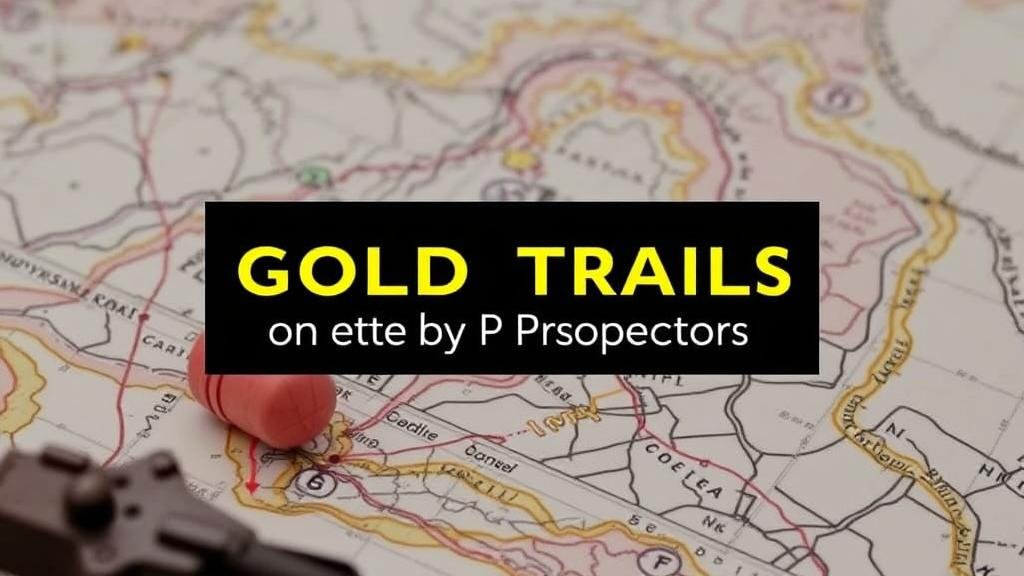How to Identify Gold Trails on Maps Left by Prospectors
How to Identify Gold Trails on Maps Left by Prospectors
The quest for gold has inspired countless prospectors throughout history, leading them to blaze trails across vast landscapes in search of riches. Understanding how to identify these historical gold trails on maps is crucial for historians, archaeologists, and modern-day treasure hunters. This article explores the methodologies and techniques used to locate these valuable paths, providing both historical context and practical advice.
Understanding Gold Trails and Their Significance
Gold trails refer to the routes taken by prospectors searching for gold during various gold rushes, notably during the 19th century. e trails often correlate with significant geological formations and mineral deposits that led to the discovery of gold. Recognizing these trails serves not only to preserve history but also can lead to potential new discoveries.
Gold trails can be discerned through various means, including map analysis, historical documents, and local lore. The significance of identifying these trails lies in their capacity to offer insights into past economic activities and migratory patterns, allowing modern researchers to piece together a larger narrative about societal development during these periods.
Analyzing Historical Maps
To identify gold trails effectively, one must become proficient in reading and analyzing historical maps. e maps often provide invaluable data regarding old mining routes, topographical features, and settlement patterns. Here are techniques to consider:
- Topographic Features: Examine the elevation and terrain features depicted on the map. Gold trails typically follow natural landforms such as rivers, valleys, or mountain passes, which facilitated easier travel.
- Mining Claims: Many historical maps indicate locations of old mining claims. Areas with high concentration of claims often coincide with trails used by prospectors heading to those sites.
- Settlements and Landmarks: Identify former towns or landmarks such as mills, water sources, and trading posts that served as critical points along the trails.
Utilizing Technology for Trail Identification
Modern technology enhances our ability to locate historical gold trails. Geographic Information Systems (GIS) and satellite imagery allow researchers to overlay historical maps with current geographical data. This technology supports the integration of various datasets to reveal potential trails. Also, these tools can help identify environmental changes such as deforestation or urban development that may have obscured original trails.
Case Studies: Notable Gold Trails
Examining specific case studies can illuminate the techniques used to identify gold trails. For example, the California Gold Rush of 1849 led to the establishment of numerous trails across the Sierra Nevada. Research into the Donner Pass area showcases a convergence of historical resources, where prospectors traversed well-defined pathways while establishing mining camps.
Another notable example is the Klondike Gold Rush in the Yukon Territory, where the paths taken by prospectors from Skagway to Dawson City reveal critical insights. Historical accounts combined with terrain analysis indicate preferred routes that were not only the fastest but also the safest during harsh weather conditions.
Archaeological Insights
Archaeological exploration plays a key role in identifying and verifying the existence of gold trails. Artifacts such as tools, mining equipment, and remnants of campsites provide tangible evidence of prospecting activities. Excavations along suspected trails can yield important data that supports findings from historical maps and documents.
Legal and Ethical Considerations
When exploring gold trails, it is essential to consider legal and ethical dimensions. Many trails and associated sites may be on protected lands or private property, requiring permissions and adherence to local laws regarding mining and excavation. Also, respect for Indigenous lands and traditions is paramount, and researchers should engage with local communities to honor their perspectives and rights.
Actionable Takeaways
Identifying gold trails on historical maps is an expansive process that requires both historical knowledge and modern technology. Here are key actionable steps for anyone interested in pursuing this endeavor:
- Familiarize yourself with historical maps and mining documentation relevant to the area of interest.
- Use GIS tools to overlay historic data with modern geographical layouts.
- Conduct field research and archaeological investigations responsibly and ethically.
- Engage with local historians and communities to enrich your understanding of the trails and their significance.
In closing, the identification of gold trails left by prospectors is an endeavor that combines history, geography, and archaeology. With diligence and respect for the past, modern adventurers can uncover paths lined with rich narratives waiting to be explored.



